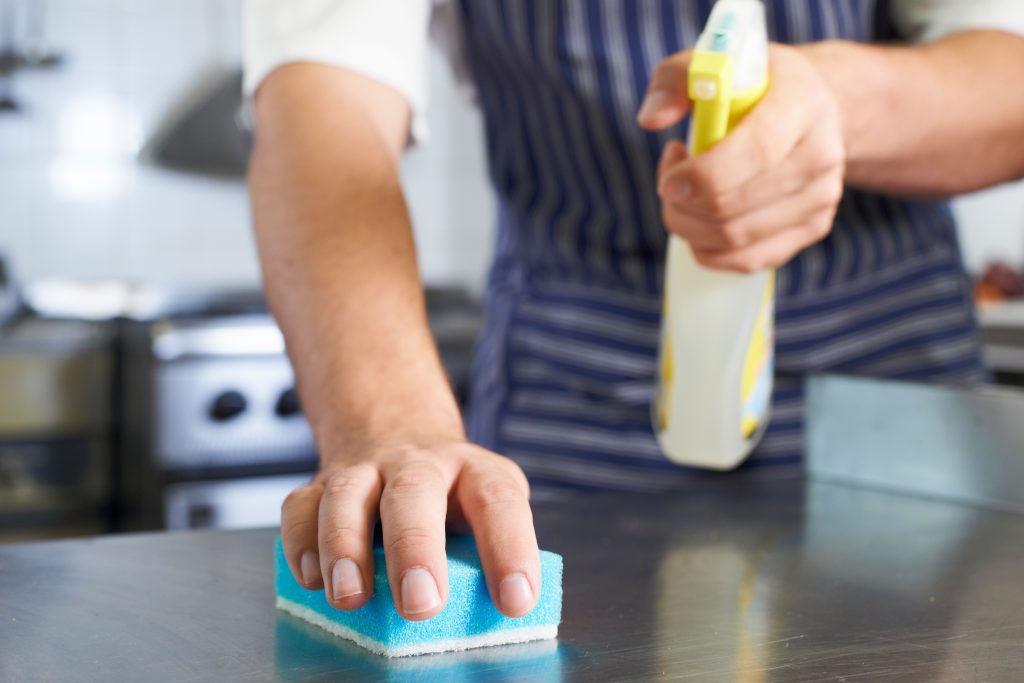Cleaning Kitchen Surfaces – 6 Steps for Proper Hygiene

There is a difference between ‘clean‘ and ‘looking clean‘. ‘Shiny syndrome‘ often affects our judgement when cleaning kitchen surfaces. As a result, appearing spotless does not mean that a work surface is safe for food. In reality, the microscopic nature of bacteria means you cannot often see the danger.
6 Steps to Cleanliness
Consequently, you must have a disciplined, effective cleaning regimen for your kitchen, like a clean-as-you-go policy. Whilst we can’t cover all the requirements for such a policy in this one article, we can share a few steps to consider when cleaning.
- Read the label.
Cleaning products often have clear instructions on them about the amount required and effective application. Over-application is not likely to make any real difference to the cleanliness of the surface. In fact, you may simply cause a chemical rather than biological hazard if you overuse cleaning agents. Sticky pub tables and bar tops are actually often caused by overuse of chemicals and not drink residue.
- Clean your cleaner?
Your cleaning materials must be clean, too. No matter how good a cleaning agent is at killing bacteria, if you wipe it down with dirty cloth you are probably achieving nothing at all. Mops, sponges and other items should have one purpose and must be cleaned or replaced regularly.
- Clean yourself!
Your own personal hygiene is very important. Cross-contamination from hands is a common cause of food poisoning, so frequent washing is important. Remember to wash after you have been cleaning surfaces before you start to work with food. If you are unwell, don’t handle food.
- Prepare against cross-contamination.
Cleaning a surface is far easier if you know what substance you are dealing with. Have clear preparation areas for different foodstuffs. Pay attention to the cleaning of high-risk food prep areas such as those for raw chicken, to avoid cross-contamination. Mishandling poultry, in particular, is an easy way to spread harmful bacteria around the kitchen.
- Check your corners.
Remember that the corners and edges of where surfaces meet walls are hotbeds for bacteria. When you are cleaning, make sure you get to the edges of tables and chopping boards. Grouting between tiles can host a plethora of nasty bacteria, in particular.
- Attack hidden bacteria!
As aforementioned, ‘clean’ and ‘looking’ clean are very different. Wipe away your debris and obvious physical contamination, then assume further. The human eye cannot see bacteria, so you should still follow the cleaning process to its end, no matter the surface’s appearance. You don’t want to find out the consequences of poor hygiene simply because you were fooled by ‘shiny syndrome’.
Where to Go Next?
Hygienic work areas are vital for avoiding food poisoning, so a good cleaning regime is key to kitchen safety.
However, cleaning kitchen surfaces is just one element of proper food hygiene practice. It is a legal requirement that your staff be able to demonstrate understanding of this. Our RoSPA-accredited Level 2 Food Hygiene courses are informative, easy-to-navigate and perfect evidence for the Environmental Health Officer that your kitchen is in safe hands. Train your entire staff online, today.
